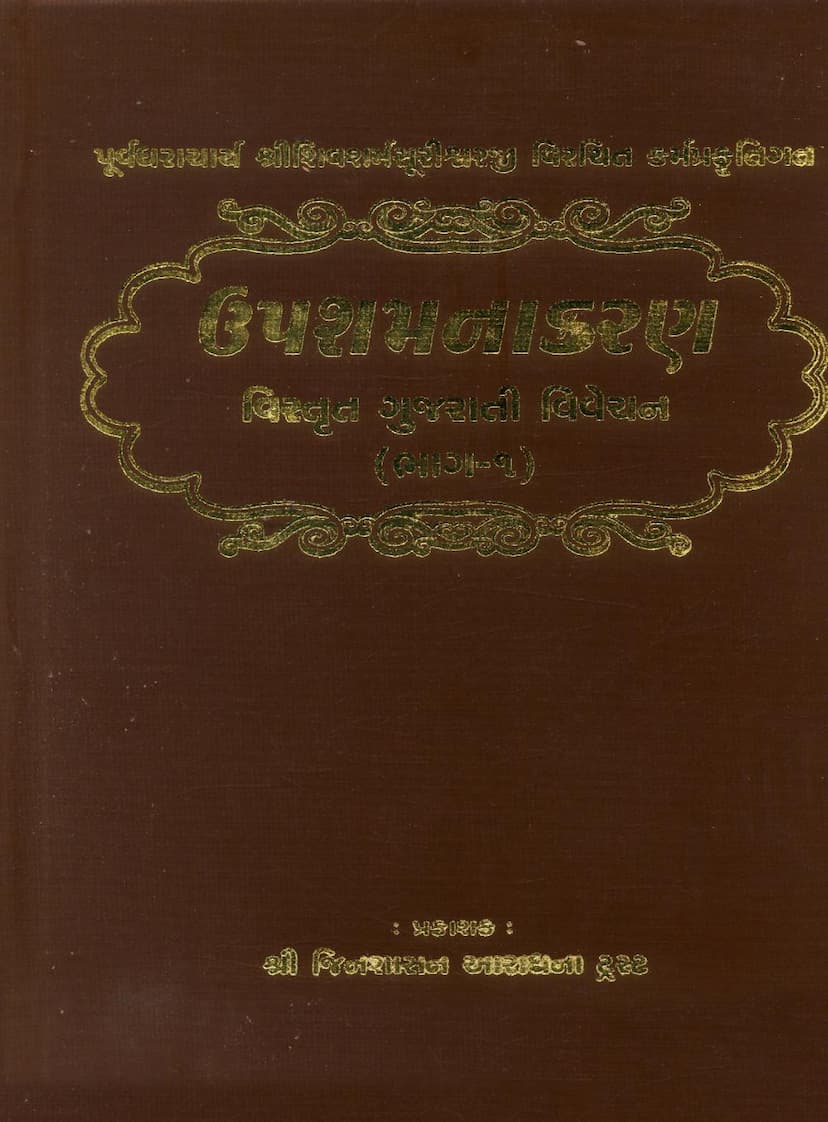Upshamanakaran Part 01
Added to library: September 2, 2025

Summary
Based on the provided text, here's a comprehensive summary of "Upshamanakaran Part 01" by Hemchandrasuri, published by Jinshasan Aradhana Trust:
Overall Purpose and Content:
This book, "Upshamanakaran Part 01," is an extensive Gujarati commentary on the "Upshamanakaran Adhikar" (section on pacification) from the "Karmaprakruti" (Nature of Karma), a fundamental Jain text on karma theory. It aims to explain in detail the complex concepts of Jain karma literature, particularly focusing on the path of spiritual purification and liberation.
Key Figures and Contributions:
The book is a tribute to the lineage of Jain Acharyas and highlights the efforts of various scholars in preserving and propagating Jain knowledge.
- Author of the Original Text: The original "Karmaprakruti" text, which includes the "Upshamanakaran Adhikar," is attributed to Acharya Shri Shivsharma Suri, a known Pūrvadhara (possessor of Pūrvas, ancient Jain scriptures).
- Commentary and Guidance: The extensive Gujarati commentary is attributed to Muni Shri Hemachandra Vijayji Maharaj, who is also the "Vivechakkar" (commentator). He was inspired by the teachings and vast knowledge of Paramaguru Shri Siddhanta Mahodadhi Acharya Dev Shrimad Vijay Premasurishwarji Maharaj, the guiding force behind the extensive karma literature compilation.
- Compilation and Organization: Munishri Jayghosh Vijayji Maharaj (currently Acharya Dev Shrimad Vijay Jayghosh Surishwarji Maharaj) and Munishri Dharmanand Vijayji Maharaj (currently Acharya Dev Shrimad Vijay Dharmjit Surishwarji Maharaj) played significant roles in collecting and organizing the "Padarth Sangrahak" (compilers of substances/concepts).
- Publisher: The book was published by Shri Jinshasan Aradhana Trust, Mumbai, indicating a trust dedicated to the propagation of Jain scriptures.
- Inspiration and Patronage: Several respected Acharyas and Panyas (scholars) like Acharya Dev Shrimad Vijay Premasurishwarji Maharaj, Acharya Dev Shrimad Vijay Bhuvanbhanusurishwarji Maharaj, and Panyas Shri Padm Vijayji Ganivarya are mentioned for their divine blessings and inspiration.
Historical and Contextual Information:
- Origin of the Commentary: The commentary was prepared approximately fifty years prior to its publication but remained unpublished for various reasons. The current publication was initiated and overseen by Acharya Dev Shrimad Vijay Jayghosh Surishwarji Maharaj, with the diligent efforts of Acharya Dev Shrimad Vijay Hemachandra Surishwarji Maharaj for about two years to bring it to fruition.
- Pindwada Connection: The town of Pindwada in Rajasthan is highlighted as the spiritual birthplace of Acharya Dev Shrimad Vijay Premasurishwarji Maharaj. The Pindwada Jain Sangh has provided significant support for the publication.
- Jain Philosophy: The introduction emphasizes the core tenets of Indian philosophies originating from Aryabhumi (India), including the existence of the soul, the concept of purity through the removal of impurities (karma), and the ultimate goal of liberation (moksha). It contrasts this with other religions. The text also delves into the Jain perspective of the soul as both eternal and ever-changing, its omnipresence, and the unique Jain understanding of karma's intricacies.
- Karma Literature: The book places significant importance on karma literature, calling it the "heart" of Jain Agamas. It references ancient texts like "Karmaprakruti," "Kashayaprahud," and "Panchsangrah," explaining their origins and their significance in understanding karma. It also lists various ancient and modern karma granthas and their commentaries.
Key Concepts Explained (Focus on Upshamanakaran):
While the entire text is a detailed explanation of karma, the "Upshamanakaran Adhikar" is central. This section is crucial for understanding how to pacify and eventually eliminate karmic bonds. The commentary likely elaborates on:
- The nature of karma: Its various classifications, influx, bondage, transformation, and fruition.
- The process of Upashamana (Pacification): This is the core topic, explaining how karmic energies, particularly those related to Mohaniya Karma (delusion-inducing karma), are pacified. This involves detailed discussions of different stages and practices.
- The path to liberation: The text likely outlines how the pacification of karma leads to spiritual progress and ultimately to liberation from the cycle of birth and death.
- Specific processes: The commentary details various karmic processes like sthiti bandh (bondage of duration), rasa bandh (bondage of intensity), pradesh bandh (bondage of quantity), pradesh uday, sthiti uday, anubhag uday, prakriti uday, prakriti satta, sthiti satta, and anubhag satta.
- The significance of the first Samyaktya (Right Faith): The book emphasizes the Prathamoapsham Samyaktva Prapti (attainment of initial pacified right faith) as a critical step on the path.
- The role of the Three Karanas (Processes): The commentary elaborates on Yathapravartakaraṇa, Apūrvakaraṇa, and Anivṛttikaraṇa as essential stages in spiritual purification, particularly in the context of achieving Samarūpa (a state of balance and purity).
- The author's personal journey: Muni Hemachandra Vijayji shares his profound spiritual journey, his initiation under great Acharyas, his study of complex philosophical texts, and his experiences in understanding the subtle nuances of karma literature. He highlights the grace of his gurus in guiding him through this path of knowledge.
Overall Tone and Significance:
The book reflects deep reverence for Jain teachings and a commitment to spreading spiritual knowledge. It is intended for serious Jain scholars and practitioners interested in the profound science of karma and its role in spiritual progress. The detailed explanations and historical context suggest it is a significant contribution to Jain literature, making ancient wisdom accessible in Gujarati. The extensive list of published works by the trust at the end of the text further emphasizes their dedication to Shruta Bhakti (devotion to scriptures).